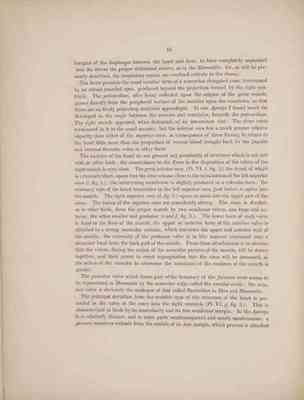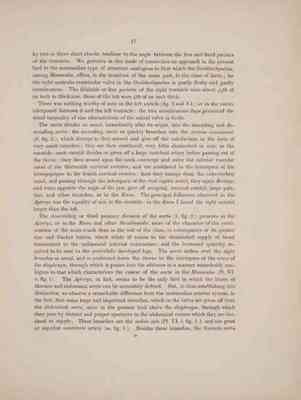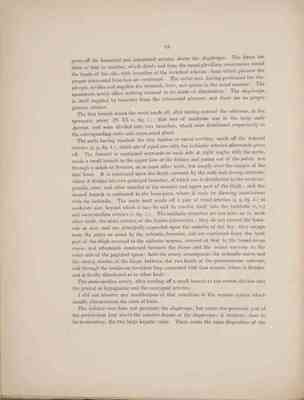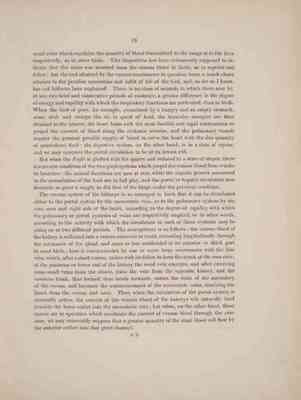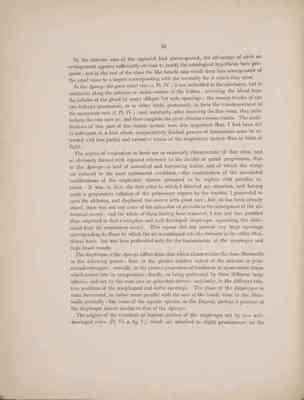Pages
36
16 margins of the diaphragm between the heart and liver, to have completely separated from the thorax the proper abdominal viscera, as in the Mammalia ; for, as will be presently described, the respiratory organs are confined entirely to the thorax.
The heart presents the usual ornithic form of a somewhat elongated cone, terminated by an obtuse rounded apex, produced beyond the projection formed by the right venricle. The pericardium, after being reflected upon the origins of the great vessels, passes directly from the peripheral surface of the auricles upon the ventricles, so that there are no freely projecting auricular appendages. In one Apteryx I found much fat developed in the angle between the auricles and ventricles, beneath the pericardium. The right auricle appeared, when distended, of an uncommon size. The three veins terminated in it in the usual manner, but the inferior cava has a much greater relative capacity than either of the superior cavae, in consequence of these having to return to the heart little more than the proportion of venous blood brought back by the jugular and internal thoracic veins in other birds.
The auricles of the heart do not present any peculiarity of structure which is not met with in other birds ; the resemblance to the Emeu in the disposition of the valves of the right auricle is very close. The great inferior cava, (Pl. VI. b,fig. 3.) the trunk of which is extremely short, opens into the sinus venosus close to the termination of the left superior cava (c,fig.3.) ; the intervening membrane is slightly produced in a valvular form : the coronary vein of the heart terminates in the left superior cava, just before it opens into the auricle. The right superior cava (d,fig.3.) opens as usual into the upper part of the sinus. The Tunics of the superior cavae are remarkably strong. The sinus is divided, as in other birds, from the proper auricle by two semilunar valves, one large and anterior, the other smaller and posterior (e and f, fig.3.). the lower horn of each valve is fixed to the floor of the auricle, the upper or anterior horn of the anterior valve is attached to a strong muscular column, which traverses the upper and anterior wall of the auricle ; the extremeity of the posterior valve is in like manner continued into a muscular band from the back part of the auricle. From these attachments it is obvious that the valves, during the action of the muscular parietes of the auricle, will be drawn together, and their power to resist regurgitation into the sinus will be increased, as the action of the muscles to overcome the resistance of the contents of the auricle is greater.
The posterior valve which forms part of the boundary of the foramen ovale seems to be represented in Mammalia by the muscular ridge called the annulus ovalis ; the anterior valve is obviously the analogue of that called Eustachian in Man and Mammalia.
The principal deviation from the ornithic type of the structure of the heart is presented in the valve at the entry into the right ventricle (Pl. VI. g,fig.3.). This is characterized in birds by its mascularity and its free semilunar margin. In the Apteryx it is relatively thinner, and in some parts semitransparent and nearly membranous : a process moreover extends from the middle of its free margin, which process is attached
37
17
by two or three short chordoe tendineoe to the angle between the free and fixed parietes of the ventricle. We perceive in this mode of connection an approach in the present bird to the mammalian type of structure of the same part, to the class of birds ; for the right auriculo-ventricular valve in the Ornithorhynchus is partly fleshy and partly membranous. The dilatable or free parietes of the right ventricle were about 1/20th of an inch in thickness, those of the left were 1/6th of an inch thick.
There was nothing worthy of note in the left auricle (fig.2 and 3 h,0 or in the valves interposed between it and the left ventricle : the two membranous flaps presented the usual inequality of size characteristic of the mitral valve in birds.
The aorta divides as usual, immediately after its origin, into the ascending and descending aortae : the ascending aorta as quickly branches into the arterioe innominatoe (d, fig.2.), which diverge as they ascend and give off the subclavians in the form of very small branches ; they are then continued, very little diminished in size, as the carotids ; each carotid divides or gives off a large vertebral artery before passing out of the thorax ; they then mount upon the neck, converge and enter the inferior vascular canal of the thirteenth cervical vertebra and are continued in the interspace of the haemapophyses to the fourth cervical vertebra : here they emerge from the subvertebral canal, and passing through the interspace of the recti capitis antici, they again diverge, and when opposite the angle of the jaw, give off occipital, intenal carotid, large palatine, and other branches, as in the Emeu. The principal difference observed in the Apteryx was the equality of size in the carotids : in the Emeu I found the right carotid larger than the left.
The descending or third primary division of the aorta (k,fig.2.) presents in the Apteryx, as in the Emeu and other Struthionidoe, more of the character of the continuation of the main-trunk than in the rest of the class, in consequence of its greater size and thicker tunics, which relate of course to the diminished supply of blood transmitted to the rudimentary anterior extremities ; and the increased quantity required to be sent to the powerfully developed legs. The aorta arches over the right bronchus as usual, and is continued down the thorax to the interspace of the crura of the diaphragm, through which it passes into the abdomen in a manner remarkable analogous to that which characterizes the course of the aorta in the Mammalia (Pl.VI. n, fig. 1). The Apteryx, in fact seems to be the only bird in which the limits of thoracic and abdominal aorta can be accurately defined. But, in thus establishing this distinction, we observe a remarkable difference from the mammalian arterial system, in the fact, that some large and important branches, which in the latter are given off from the abdominal aorta, arise in the present bird above the diaphragm, through which they pass by distinct and proper apertures to the abdominal viscera which they are destined to supply. These branches are the coeliac axis (Pl. VI. l, fig.1.) and the great or superior mesenteric artery (m, fig.1.). Besides these branches, the thoracic aorta
D
38
18
gives off the bronchial and intercostal arteries above the diaphragm. the latter are three or four in number, which divide and form the usual plexiform anastomoses round the heads of the ribs, with branches of the vertebral arteries ; from which plexuses the proper intercostal branches are continued. The coeliac axic, having perforated the diaphragm, divides and supplies the stomach, liver, and spleen in the usual manner. The mesenteric artery offers nothing unusual in its mode of distribution. The diaphragm is itself supplied by branches from the intercostal plexuses, and there are no proper phrenic arteries.
The first branch which the aorta sends off, after having entered the abdomen, is the spermatic artery (Pl. VI. o, fig. 1.) ; this was of moderate size in the large male Apteryx, and soon divided into two branches, which were distributed respectively to the corresponding testis and supra-renal gland.
The aorta having reached the first lumbar or sacral vertebra, sends off the femoral arteries (p,p, fig. 1.), which are of equal size with the ischiadic arteries afterwards given off. The femoral is continued outwards on each side at right angles with the aorta, sends a small branch to the upper lobe of the kidney and passes out of the pelvis, not through a notch or foremen, as in most other birds, but simply over the margin of the iliac bone. It is continued upon the thigh, covered by the wide and strong sartorius, where it divides into two principal branches, of which one is distributed to the sartorius, gracilis, vasti and other muscles at the anterior and upper part of the thigh ; and the second branch is continued to the knee-joint, where it ends by forming anastomoses with the ischiadic. the aorta next sends off a pair of renal arteries (q,q, fig.1.) of moderate size, beyond which it may be said to resolve itself into the ischiadic (r, r,) and sacro-median arteries (s, fig.1.). The ischiadic branches are not here, as in most other birds, the main arteries of the hinder extremities ; they do not exceed the femorals in size, and are principally expended upon the muscles of the leg : they escape from the pelvis as usual by the ischiadic foramina, and are continued down the back part of the thigh external to the adductor magnus, covered at first by the broad biceps cruris, and afterwards continued between the biceps and the vastus externus to the outer side of the popliteal space : here the artery accompanies the ischiadic nerve and the strong tendon of the biceps between the two heads of the gastrocnemius externus, and through the tendinous trochlear loop connected with that muscle, where it divides, and is finally distributed as in other birds.
The sacro-median artery, after sending off a small branch to the rectum, divides into the genital or hypogastric and the coccygeal arteries.
I did not observe any modification of that condition of the venous system which usually characterizes the class of birds.
The inferior cava deos not perforate the diaphragm, but enters the posterior part of the pericardium just above the anterior fissure of the diaphragm : it receives, close to its termination, the two large hepatic veins. There exists the same disposition of the
39
19
renal veins which regulates the quantity of blood transmitted to the lungs or to the liver respectively, as in other birds. This disposition has been erroneously supposed to indicate that the urine was secreted from the venous blood in birds, as in reptiles and fishes ; but the end attained by the venous anastomoses in question bears a much closer relation to the peculiar necessities and habit of life of the bird, and so far as I know, has not hitherto been explained. There is no class of animals in which there may be, at any two brief and consecutive periods of existence, a greater difference in the degree of energy and rapidity with which the respiratory functions are performed, than in birds. When the bird of prey, for example, stimulated by a hungry and an empty stomach, soars aloft and sweeps the air in quest of food, the muscular energies are then strained to the utmost, the heart beats with the most forcible and rapid contractions to propel the current of blood along the systemic arteries, and the pulmonary vessels require the greatest possible supply of blood to serve the heart with the due quantity of arterialized fluid : the digestive system, on the other hand, is in a state of repose, and we may conceive the portal circulation to be at its lowest ebb.
But when the Eagle is glutted with his quarry and reduced to a state of stupor, there is a reverse condition of the two great systems which propel the venous blood from trunks to branches : the animal functions are now at rest, while the organic powers concerned in the assimilation of the food are in full play, and the portal or hepatic circulation now demands as great a supply as did that of the lungs under the previous condition.
The venous system of the kidneys is so arranged in birds that it can be distributed either to the portal system by the mesenteric vein, or to the pulmonary system by the vena cava and right side of the heart, according to the degree of rapidity with which the pulmonary or portal systems of veins are repectively emptied, or in other words, according to te activity with which the circulation in each of these systems may be going on at two different periods. The arrangement is as follows : the venous blood of the kidney is collected into a venous reservoir or trunk extending longitudinally through the substance of the gland, and more or less subdivided at its anterior or thick part in most birds ; here it communicates by one or more large anastomoses with the iliac vein, which, after a short course, unites with its fellow to form the trunk of the vena cava ; at the posterior or lower end of the kidney the renal vein emerges, and after receiving some small veins from the cloaca, joins the vein from the opposite kidney, and the common trunk, thus formed, then bends forwards, enters the folds of the mesentery of the rectum, and becomes the commencement of the mesenteric veins, receiving the blood from the rectum and coeca. Thus, when the circulation of the portal system is unusually active, the current of the venous blood of the kidneys will naturally tend towards the lower outlet into the mesenteric vein; but when, on the other hand, those causes are in operation which accelerate the current of venous blood through the vena cava, we may resonably suppose that a greater quantity of the renal blood will flow by the anterior outlets into that great channel.
D2
40
20
In the extreme case of the raptorial bird above-quoted, the advantage of such an arrangement appears sufficiently obvious to justify the teleological hypothesis here proposed ; and in the rest of the class the like benefit may result from this arrangement of the renal veins to a degree corresponding with the necessity for it which may exist.
In the Apteryx the great renal vein (s,Pl.IV.) is not embedded in the substance, but is continued along the anterior or under-surface of the kidney, receiving the blood from the lobules of the gland by many oblique but wide openings ; the venous trunks of the two kidneys anastomose, as in other birds, posteriorly, to form the commencement of the mesenteric vein (t, Pl. IV.) ; and, anteriorly, after receiving the iliac veins, they unite to form the vena cava (u), and thus complete the great circulus venosus renalis. The modifications of this part of the venous system were less important than I had been led to anticipate in a bird whose comparatively limited powers of locomotion must be attended with less partial and excessive action of the respiratory system than in birds of flight.
The organs of respiration in birds are so eminently characteristic of that class, and so obviously framed with especial reference to the faculty of aerial progression, that in the Apteryx - a bird of nocturnal and burrowing habits, and of which the wings are reduced to the most rudimental condition, - the examination of the associated modifications of the respiratory system promised to be replete with peculiar interest. It was, in fact, the first point to which I directed my attention, and having made a preparatory inflation of the pulmonary organs by the trachea, I proceeded to open the abdomen, and displaced the viscera with great care ; but, as has been already stated, there was not any trace of the extension of air-cells in the interspaces of the abdominal viscera ; and the whole of them having been removed, I was not less gratified than surprised to find a complete and well-developed diaphragm separating the abdominal from the respiratory cavity. This septum did not present any large openings corresponding to those by which the air is continued into the abdomen in the other Struthious birds, but was here perforated only for the transmission of the oesophagus and large blood-vessels.
The diaphragm of the Apterys differs from that which characterizes the class Mammalia in the following points ; first, in the greater relative extent of the anterior or poststernal interspace ; secondly, in the greater proportion of tendinous or aponeurotic tissue which enters into its composition ; thirdly, in being perforated by three different large arteries, and not by the vena cava or splanchnic nerves ; and lastly, in the different relative positions of the oesophageal and aortic openings. the plane of the diaphragm is more horizontal, or rather more parallel with the axis of the trunk, than in the Mammalia generally ; but some of the aquatic species, as the Dugong, present a position of the diaphragm almost similar to that of the Apteryx.
The origins of the vertebral or lumbar portion of the diaphragm are by two welldeveloped crura (Pl. VI. a, fig. 1.), which are attached to slight prominences on the
